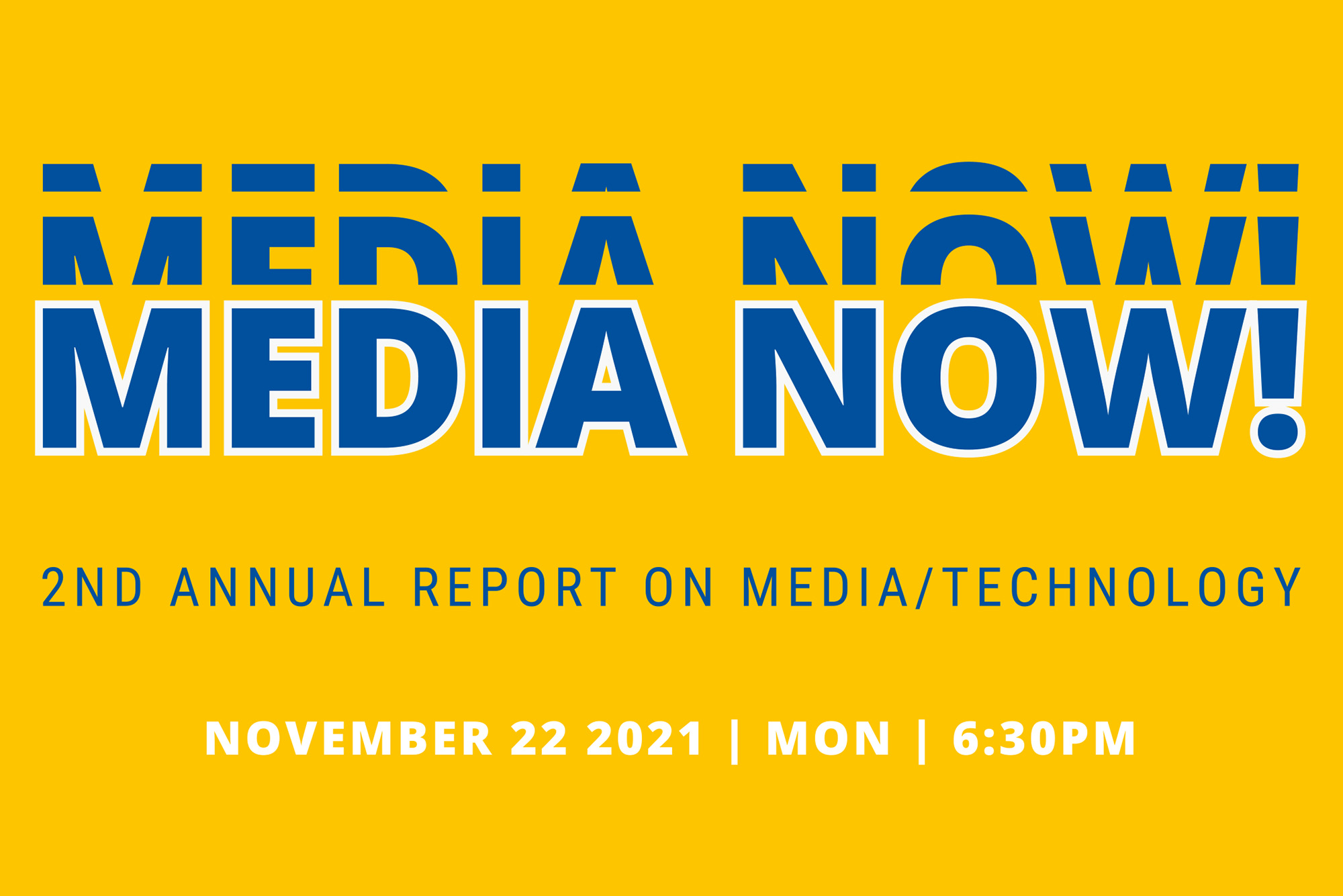COM Students: Here Are the Current Media Trends to Look for and What’s Coming Soon

The cover of the 2021 Media Now report. Photo courtesy of Media Now
COM Students: Here Are the Current Media Trends to Look for and What’s Coming Soon
Meetings via virtual reality and a QR code that can tell you the origins of the steak you’re about to buy
“Attending” a Billie Eilish concert through VR headgear. QR codes that let you learn more about the farm that grew and processed the meat you’re about to buy at the grocery store. And a microchip inserted into your brain that could act as a translator in a different country.
These are three media trends that are either already here or on their way soon, according to students in the College of Communication Writing for Communication (CM331) course. Their final assignment was to create a report on what they think are the most exciting current media trends, garnered from their class work, readings, and their own media consumption. They named the report Media Now and it can be viewed here.
The assignment came from Craig Sender, a COM lecturer in mass communication, advertising, and public relations. Sender modeled the idea on a similar Syracuse University Newhouse School of Public Communications class annual assignment, designed by Sean Branagan, director of the school’s Center for Digital Media Entrepreneurship. Branagan’s version is called Media-Nxt.
“The convergence of media and tech is a major theme of my course every year,” says Sender, who earned both undergrad and grad degrees from Newhouse. “The students at Syracuse focused on what’s next, so I thought to focus on what’s happening now. I thought the BU community should know about this stuff and how it affects them in their everyday lives. I thought it would be a shame for this info to stay in the classroom.”
Sender has worked in the media industry for 25 years, and he says this kind of forward-thinking industry report is something that would happen at a PR or media agency. “You would be working collaboratively on this kind of report, tapping the expertise of your colleagues, your CEO, your client,” he says. “So that’s how we modeled the class. I hope it can prepare them for situations they might face at their jobs or their internships.”
Journalism major Patrick Donnelly (COM’22) was the project’s editor in chief, overseeing the 17 other students in the class as they collaborated on the report. They broke off into three sections (the metaverse, the internet of things [IoT], and the influence of film and television) to write summaries of current trends and what to expect in the near future.
Read their findings here:
- Metaverse
If you hear the word “metaverse” thrown around and are too embarrassed to admit you don’t know exactly what it is, you’re not alone. The metaverse connects our real world with a virtual one, allowing people to interact digitally as if they are in the same room, according to the Media Now report. “Anyone can put on a virtual reality headset and enter the three-dimensional metaverse, where you can play games, exercise, attend concerts, and meet people—all as a digital avatar of yourself,” the students write.
Companies are now getting in the mix. Facebook (which recently changed its name to “Meta” to reflect the company’s role in building the metaverse) launched Horizon Workrooms, and Microsoft will soon release Mesh, both designed to be platforms that allow users to have meetings with avatars of their colleagues, which is especially useful as many companies have adopted work from home opportunities.
“Many concertgoers are listening to live musical performances from artists—such as Billie Eilish, Marshmello, and Ariana Grande—through VR headgear with spatial audio and imaging,” the report says. “In May, Gucci Garden was opened on [the digital platform] Roblox, [where] limited Gucci collections were available through the platform.” Millions of users could spend up to $9 to dress their avatars, although a virtual limited-edition Gucci Dionysus Bag with Bee resold for more than $4,100 on Roblox.

- Internet of things
“The Internet of Things is an extension of the internet’s use and connection, which can also be referred to as internet-connected or ‘smart,’” the students write. “Anything with an embedded computer system or sensor that uses the internet falls under IoT…[like] wearable devices, environmental monitors, virtual reality systems, laundry machines, smart monitors, vehicles, and more.” These devices can even share this information with each other on occasion.
Take transportation. IoT helps provide smart transportation by decreasing the amount of energy used and saving people time. “For example, vehicle consumption lowers when clear and accurate information is exchanged between public transit systems, people’s personal devices, GPS and traffic reports, and lights,” the students say.
In the future, the students predict that transparency of information could be used in the food supply chain. Imagine a supermarket customer being able to scan the QR code on the steak they’re about to put in their cart: they could potentially learn the “animal’s production process from breeding to packaging and selling, which further ensures food safety,” the report reads.
- Influence of film and television
Streaming services mean more people have access to video content than ever before, and movies and documentaries often highlight societal issues, disseminate information, and according to the report, “influence the audience on how to think about and perceive certain topics.” Examples the students cited include When They See Us, the Emmy-winning 2019 Netflix limited series by Ava DuVernay about the true story of five Black teenagers falsely accused of the brutal rape and assault of a white female jogger in Central Park in 1989, and Bombshell, the 2019 feature film about the accounts of sexual harrassment reported by women working at Fox News.
“This exercise was rewarding since it was something where we got 18 people to come together, add their own thoughts, and work on a deadline without much input from our professor,” Donnelly says. “It was great to see a student-driven effort, and it was cool to see it come together in the end.”
Read the full Media Now report here.

Comments & Discussion
Boston University moderates comments to facilitate an informed, substantive, civil conversation. Abusive, profane, self-promotional, misleading, incoherent or off-topic comments will be rejected. Moderators are staffed during regular business hours (EST) and can only accept comments written in English. Statistics or facts must include a citation or a link to the citation.